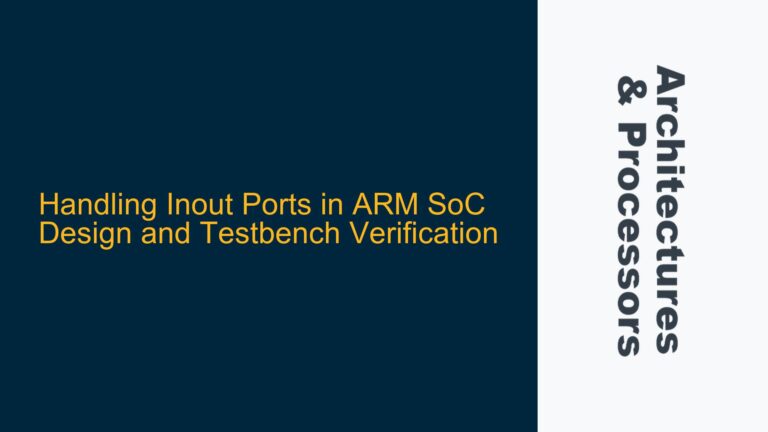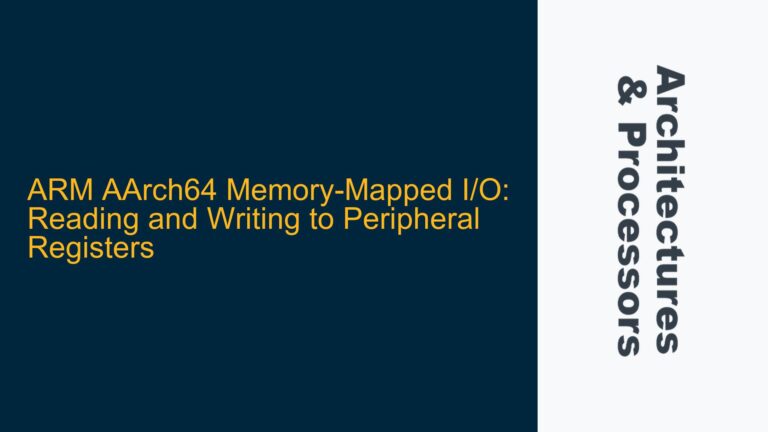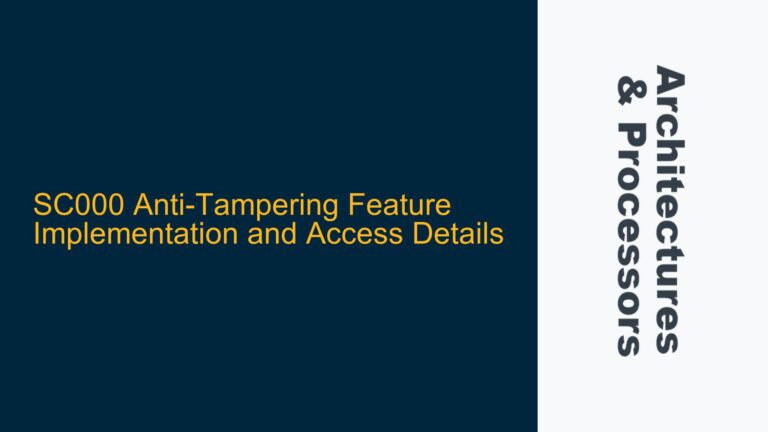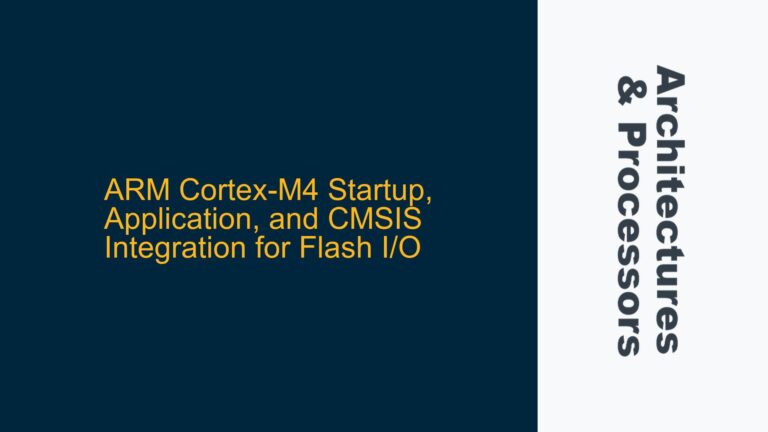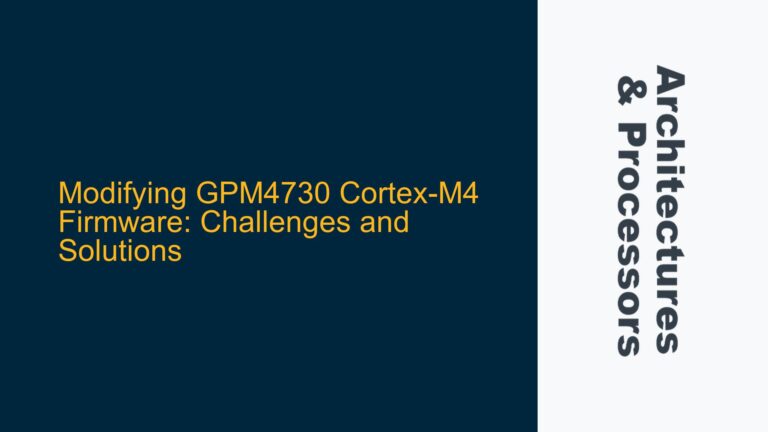ARMv8 Translation Table Descriptor Bitfield Calculations for 4KB Granules
The ARMv8 architecture employs a sophisticated memory management system that relies on translation tables to map virtual addresses to physical addresses. These translation tables use descriptors, which are essentially entries in the table that define the properties of a memory region. Two primary types of descriptors are used: block descriptors and table descriptors. Block descriptors map large contiguous memory regions, while table descriptors point to another level of translation tables, enabling hierarchical memory management. Understanding how the bitfields in these descriptors are calculated is crucial for correctly configuring the memory management unit (MMU) and ensuring proper address translation.
In the context of a 4KB translation granule, the ARMv8 architecture uses a 48-bit virtual address space. This address space is divided into multiple levels of translation tables, with each level responsible for mapping a portion of the virtual address. The bitfields in the descriptors, such as the output address (OA) field, are derived from the virtual address and determine the physical address range that the descriptor maps. For example, in a block descriptor, bits 47:30 of the virtual address are used to specify the output address for a 1GB memory region. This may seem counterintuitive at first, as 18 bits (bits 47:30) are used to specify a 1GB region, but this is because the remaining 30 bits (bits 29:0) are used to address within the 1GB block.
The confusion often arises from the interplay between the bitfields in the descriptor and the granularity of the memory mapping. For a 4KB granule, the block descriptor maps a 1GB region, and the table descriptor points to the next level of translation tables. The values of these bitfields, such as the output address, are derived from the virtual address and are used to calculate the physical address range that the descriptor maps. Understanding how these bitfields are calculated is essential for correctly configuring the translation tables and ensuring proper memory management in ARMv8 systems.
Deriving Output Address Bitfields in Block and Table Descriptors
The output address (OA) bitfields in ARMv8 translation table descriptors are derived from the virtual address and are used to specify the physical address range that the descriptor maps. For a 4KB translation granule, the block descriptor maps a 1GB memory region, and the table descriptor points to the next level of translation tables. The bitfields in these descriptors are calculated based on the virtual address and the granularity of the memory mapping.
In the case of a block descriptor, bits 47:30 of the virtual address are used to specify the output address for a 1GB memory region. This may seem counterintuitive, as 18 bits are used to specify a 1GB region, but this is because the remaining 30 bits (bits 29:0) are used to address within the 1GB block. The 18 bits (bits 47:30) specify the base address of the 1GB region, while the lower 30 bits (bits 29:0) are used to address within that region. This allows the block descriptor to map a contiguous 1GB region of memory.
For a table descriptor, the output address bitfields are used to point to the next level of translation tables. The table descriptor contains the base address of the next level of translation tables, and the virtual address is used to index into that table. The bitfields in the table descriptor are calculated in a similar manner to the block descriptor, but instead of mapping a large contiguous region of memory, the table descriptor points to another level of translation tables, enabling hierarchical memory management.
The calculation of these bitfields is based on the virtual address and the granularity of the memory mapping. For a 4KB granule, the block descriptor maps a 1GB region, and the table descriptor points to the next level of translation tables. The bitfields in these descriptors are derived from the virtual address and are used to calculate the physical address range that the descriptor maps. Understanding how these bitfields are calculated is essential for correctly configuring the translation tables and ensuring proper memory management in ARMv8 systems.
Configuring ARMv8 Translation Tables for 4KB Granules
Configuring ARMv8 translation tables for a 4KB granule involves understanding how the bitfields in the block and table descriptors are calculated and how they are used to map virtual addresses to physical addresses. The block descriptor maps a 1GB memory region, and the table descriptor points to the next level of translation tables. The bitfields in these descriptors are derived from the virtual address and are used to calculate the physical address range that the descriptor maps.
To configure the translation tables, you must first determine the base address of the memory region that you want to map. For a block descriptor, this involves calculating the output address (OA) bitfields based on the virtual address. The output address is specified by bits 47:30 of the virtual address, and the remaining 30 bits (bits 29:0) are used to address within the 1GB block. This allows the block descriptor to map a contiguous 1GB region of memory.
For a table descriptor, the output address bitfields are used to point to the next level of translation tables. The table descriptor contains the base address of the next level of translation tables, and the virtual address is used to index into that table. The bitfields in the table descriptor are calculated in a similar manner to the block descriptor, but instead of mapping a large contiguous region of memory, the table descriptor points to another level of translation tables, enabling hierarchical memory management.
Once the bitfields in the descriptors have been calculated, you can configure the translation tables by writing the appropriate values to the descriptor entries. This involves setting the output address bitfields, as well as other attributes such as memory type, access permissions, and shareability. After the translation tables have been configured, you can enable the MMU and begin using the virtual address space.
Understanding how the bitfields in the block and table descriptors are calculated is essential for correctly configuring the translation tables and ensuring proper memory management in ARMv8 systems. By following these steps, you can configure the translation tables for a 4KB granule and ensure that virtual addresses are correctly mapped to physical addresses.
Troubleshooting Common Issues with ARMv8 Translation Table Configuration
When configuring ARMv8 translation tables, several common issues can arise, particularly when dealing with the bitfields in the block and table descriptors. One common issue is incorrectly calculating the output address (OA) bitfields, which can result in incorrect memory mapping. This can occur if the bitfields are not derived correctly from the virtual address or if the granularity of the memory mapping is not taken into account.
Another common issue is misconfiguring the attributes in the descriptors, such as memory type, access permissions, and shareability. These attributes determine how the memory region is accessed and shared between different processors, and misconfiguring them can result in memory access violations or data corruption. It is important to carefully configure these attributes based on the requirements of your system.
A third common issue is failing to properly enable the MMU after configuring the translation tables. The MMU must be enabled for the translation tables to take effect, and failing to do so can result in the system using the physical address space directly, bypassing the translation tables. This can lead to incorrect memory mapping and potential system crashes.
To troubleshoot these issues, you should first verify that the bitfields in the descriptors are correctly calculated based on the virtual address and the granularity of the memory mapping. This involves checking the output address bitfields in the block and table descriptors and ensuring that they correctly map the desired memory regions. You should also verify that the attributes in the descriptors are correctly configured based on the requirements of your system.
Next, you should check that the MMU is properly enabled after configuring the translation tables. This involves setting the appropriate control registers to enable the MMU and ensure that the translation tables are used for address translation. If the MMU is not enabled, the system will use the physical address space directly, bypassing the translation tables.
Finally, you should test the memory mapping by accessing the virtual address space and verifying that the correct physical addresses are accessed. This can be done using debugging tools or by writing test code that accesses the virtual address space and checks the results. If any issues are found, you should revisit the configuration of the translation tables and make any necessary adjustments.
By following these troubleshooting steps, you can identify and resolve common issues with ARMv8 translation table configuration and ensure that virtual addresses are correctly mapped to physical addresses. This will help you achieve proper memory management in your ARMv8 system and avoid potential system crashes or data corruption.

